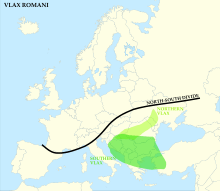Vlax Romani language
| Vlax Romani | |
|---|---|
| Native to | Bosnia, Romania, Serbia, Albania, Hungary; scattered in numerous other states |
Native speakers | 485,000 (2002–2010)[1] |
|
Indo-European
| |
| Official status | |
Recognised minority language in | |
| Language codes | |
| ISO 639-3 |
rmy |
| Glottolog |
vlax1238[2] |
 | |
Vlax Romani is a dialect group of the Romani language. Vlax Romani varieties are spoken mainly in Southeastern Europe by Romani people.[3] Vlax Romani can also be referred to as an independent language[4] or as one dialect of the Romani language. Vlax Romani is the most widely spoken dialect subgroup of the Romani language worldwide. Most Vlax Romani speakers live in Bosnia-Herzegovina (300,000) followed by Romania (241,617), Albania (60,000) and Colombia (4,850).[5]
Name
The language's name is derived from the "Vlachs", a medieval exonym referring to the Romanians, as all the Vlax dialects share an extensive influence from Romanian on vocabulary, phonology and morphology.[6] There have been many waves of migration of Roma out of Romania, some of them being connected to the 19th century abolition of slavery in Romania.[6] This name was coined by British scholar Bernard Gilliat-Smith in his 1915 study on Bulgarian Roma, in which he first divided Roma dialects into Vlax and non-Vlax, based on whether they were influenced by Romanian or not.[7]
The similarity of the words Romani and Romania is a coincidence, they are not etymologically related.
Classification
Vlax Romani is classified in two groups: Vlax I, or Northern Vlax (including Kalderash and Lovari), and Vlax II, or Southern Vlax.[3]
Elšík[8] uses this classification and dialect examples (geographical information from Matras [9]):
| Sub-group | Dialect | Place |
|---|---|---|
| Ukrainian Vlax | Ukraine | |
| Northern Vlax | Hungarian Lovari | Hungary |
| Slovak Bougešti | Slovakia | |
| Austrian Lovari | Austria | |
| Polish Lovari | Poland | |
| Norwegian Lovari | Norway | |
| Cerhari | Hungary | |
| Serbian Kalderaš | Serbia | |
| Italian Kalderaš | Italy | |
| Russian Kalderaš | Russia | |
| Taikon Kalderaš | Sweden[10] | |
| American Vlax | USA | |
| Southern Vlax | Vallachian | Romania |
| Ihtiman | Bulgaria (Ihtiman = name of a city) | |
| Gurbet | Serbia and Bosnia | |
| Korça | Albania (Korça = name of a city) | |
| Italian Xoraxane | Italy (Xoraxane means "muslims" in the dialect) | |
| Ajia Varvara | Greece (Ajia Varvara = name of a suburb of Athens) |
Writing systems
Vlax Romani is written using the Romani orthography, which is a Latin alphabet with several additional characters. In the area of the former Soviet Union it is also written in Cyrillic.
References
- ↑ Vlax Romani at Ethnologue (18th ed., 2015)
- ↑ Hammarström, Harald; Forkel, Robert; Haspelmath, Martin; Bank, Sebastian, eds. (2016). "Vlax Romani". Glottolog 2.7. Jena: Max Planck Institute for the Science of Human History.
- 1 2 Norbert Boretzky and Birgit Igla. Kommentierter Dialektatlas des Romani. Wiesbaden: Harrassowitz Verlag 2004. Teil 1: Vergleich der Dialekte.
- ↑ Ethnologue report
- ↑ The Ethnologue report; Ethnologue page on Colombia
- 1 2 Yaron Matras (2002). Romani: A Linguistic Introduction. Cambridge University Press. p. 7. ISBN 9781139433242.
- ↑ Yaron Matras (2002). Romani: A Linguistic Introduction. Cambridge University Press. p. 219. ISBN 9781139433242.
- ↑ Elšík, Viktor (1999). "Dialect variation in Romani personal pronouns" (PDF). p. 2. Retrieved 17 September 2013.
- ↑ Matras, Yaron (2002). Romani: A Linguistic Introduction, Cambridge: Cambridge University Press. ISBN 0-521-02330-0
- ↑ Hansen, Björn; de Haan, Ferdinand (2009). Modals in the Languages of Europe. Walter de Gruyter: p. 307 ISBN 978-3-11-021920-3.
External links
| Romani edition of Wikipedia, the free encyclopedia |